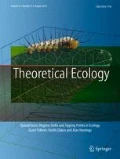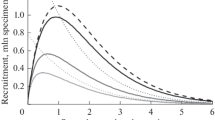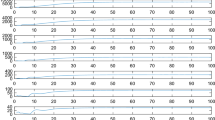Abstract
Models of stock-recruitment relationships (SRRs) are often used to predict fish population dynamics. Commonly used SRRs include the Ricker, Beverton-Holt, and Cushing functional forms, which differ primarily by the degree of density-dependent effects (compensation). The degree of compensation determines whether recruitment respectively decreases, saturates, or increases at high levels of spawning stock biomass. In 1982, J.G. Shepherd united these dynamics into a single model, where the degree of compensation is determined by a single parameter. However, the difficulty in relating this parameter to biological data has limited its usefulness. Here, we use a generalized modeling framework to show that the degree of compensation can be related directly to the functional elasticity of growth, which is a general quantity that measures the change in recruitment relative to a change in biomass. We show that the elasticity of growth can be calculated from perturbations in fish biomass, is robust to observation error, and can be used to determine general attributes of the SRR in both continuous time production models, as well as discrete time age-structured models.






Similar content being viewed by others
References
Auger P, Poggiale JC (1996) Emergence of population growth models: Fast migration and slow growth. J Theor Biol 182(2):99–108
Beverton RJH, Holt SJ (1957) On the dynamics of exploited fish populations. Springer, New York
Brooks EN, Powers JE (2007) Generalized compensation in stock-recruit functions: Properties and implications for management. ICES J Mar Sci 64(3):413–424
Calder III WA (1996) Size, function, and life history. Courier Dover Publications, Cambridge
Cushing DH (1973) The dependence of recruitment on parent stock. J Fish Res Bd Can 30:1965–1976
Cushing DH (1988) The problems of stock and recruitment. In: Fish population dynamics: the implications for management. Wiley, New York
Dirac PAM (1958) The principles of quantum mechanics. Clarendon Press, Oxford
Dorner B, Peterman RM, Haeseker SL (2008) Historical trends in productivity of 120 Pacific pink, chum, and sockeye salmon stocks reconstructed by using a Kalman filter. Can J Fish Aquat Sci 65(9):1842–1866
Fell DA (1992) Metabolic control analysis: a survey of its theoretical and experimental development. Biochem J 286(Pt 2):313–330
Fell DA, Sauro HM (1985) Metabolic control and its analysis. Eur J Biochem 148(3):555–561
Feynman R (1948) Space-time approach to non-relativistic quantum mechanics. Rev Mod Phys 20(2):367–387
Gross T, Feudel U (2006) Generalized models as a universal approach to the analysis of nonlinear dynamical systems. Phys Rev E 73(1 Pt 2)016:205
Gross T, Rudolf L, Levin SA, Dieckmann U (2009) Generalized models reveal stabilizing factors in food webs. Science 325(5941):747–750
Guckenheimer J, Holmes P (1983) Nonlinear oscillations, dynamical systems and bifurcations of vector fields. Springer, New York
Guill C, Drossel B, Just W, Carmack E (2011a) A three-species model explaining cyclic dominance of Pacific salmon. J Theor Biol 276(1):16–21
Guill C, Reichardt B, Drossel B, Just W (2011b) Coexisting patterns of population oscillations: the degenerate Neimark-Sacker bifurcation as a generic mechanism. Phys Rev E 83(2):021,910
Gulland JA (1988) The analysis of data and development of models. In: Fish population dynamics: the implications for management. Wiley, New York
Hilborn R, Mangel M (1997) The ecological detective: confronting models with data. Princeton University Press, Princeton
Horvitz C, Schemske DW, Caswell H (1997) The relative “importance” of life-history stages to population growth: prospective and retrospective analyses. In: Structured-population models in marine, terrestrial, and freshwater systems. Chapman and Hall, New York, pp 247–271
Johnson DW, Grorud-Colvert K, Sponaugle S, Semmens BX (2014) Phenotypic variation and selective mortality as major drivers of recruitment variability in fishes. Ecol Lett Early edition
Kleiber P, Argue AW, Kearney RE (1987) Assessment of Pacific Skipjack Tuna (Katsuwonus pelamis) resources by estimating standing stock and components of population turnover from tagging data. Can J Fish Aquat Sci 44(6):1122–1134
Krkosek M, Hilborn R, Peterman RM, Quinn TP (2011) Cycles, stochasticity and density dependence in pink salmon population dynamics. Proc Roy Soc B 278(1714):2060–2068
Kuehn C, Siegmund S, Gross T (2013) Dynamical analysis of evolution equations in generalized models. IMA J Appl Math 78(5):1051–1077
Kuznetsov Y (1998) Elements of applied bifurcation theory. Springer, New York
MacCall AD (2002) Use of known-biomass production models to determine productivity of west coast groundfish stocks. N Am J Fish Manage 22(1):272–279
Mangel M (2006a) An introduction to some of the problems of sustainable fisheries. In: The theoretical biologist’s toolbox: Quantitative methods for ecology and evolutionary biology. Cambridge University Press, Cambridge, pp 1–38
Mangel M (2006b) The theoretical biologist’s toolbox: Quantitative methods for ecology and evolutionary biology. Cambridge University Press, Cambridge
Mangel M, Marinovic B, Pomeroy C, Croll D (2002) Requiem for Ricker: Unpacking MSY. B Mar Sci 70(2):763–781
Mangel M, Levin P, Patil A (2006) Using life history and persistence criteria to prioritize habitats for management and conservation. Ecol Appl 16(2):797–806
Mangel M, Brodziak J, DiNardo G (2010) Reproductive ecology and scientific inference of steepness: a fundamental metric of population dynamics and strategic fisheries management. Fish Fish 11(1):89–104
Mangel M, MacCall AD, Brodziak J, Dick EJ, Forrest RE, Pourzand R, Ralston S (2013) A perspective on steepness, reference points, and stock assessment. Can J Fish Aquat Sci 70(6):930–940
Marshall CT (2009) Fish reproductive biology: implications for assessment and management. In: Jakobsen T, Fogarty M J, Megrey B A, Moksness E (eds) Fish reproductive biology: Implications for assessment and management. Wiley-Blackwell, West Sussex, pp 395–420
May RM (1974) Biological populations with nonoverlapping generations: Stable points, stable cycles, and chaos. Science 186(4164):645–647
Mchich R, Auger PM, Bravo de la Parra R, Raissi N (2002) Dynamics of a fishery on two fishing zones with fish stock dependent migrations: Aggregation and control. Ecol Model 158(1–2):51–62
Moore JW, Yeakel JD, Peard D, Lough J, Beere M (2014) Life-history diversity and its importance to population stability and persistence of a migratory fish: Steelhead in two large North American watersheds. J Anim Ecol
Morgan MJ, Perez-Rodriguez A, Saborido-Rey F, Marshall CT (2011) Does increased information about reproductive potential result in better prediction of recruitment? Can J Fish Aquat Sci 68(8):1361–1368
Munch SB, Kottas A, Mangel M (2005) Bayesian nonparametric analysis of stock-recruitment relationships. Can J Fish Aquat Sci 62(8):1808–1821
Murdoch WW (1994) Population regulation in theory and practice. Ecology 75(2):271–287
Myers RA, Barrowman NJ, Hutchings JA, Rosenberg AA (1995) Population dynamics of exploited fish stocks at low population levels. Science 269(5227):1106–1108
Perretti CT, Munch SB, Sugihara G (2013a) Model-free forecasting outperforms the correct mechanistic model for simulated and experimental data. Proc Natl Acad Sci USA 110(13):5253– 5257
Perretti CT, Sugihara G, Munch SB (2013b) Nonparametric forecasting outperforms parametric methods for a simulated multispecies system. Ecology 94(4):794–800
Radchenko VI, Temnykh OS, Lapko VV (2007) Trends in abundance and biological characteristics of pink salmon (Oncorhynchus gorbuscha) in the North Pacific Ocean. North Pac Anadromous Fish Comm Bull 4:7–21
Ricker H (1954) Stock and recruitment. Can J Fish Aquat Sci 11(5):559–623
Shelton AO, Mangel M (2011) Fluctuations of fish populations and the magnifying effects of fishing. Proc Natl Acad Sci USA 108(17):7075–7080
Shepherd J (1982) A versatile new stock-recruitment relationship for fisheries, and the construction of sustainable yield curves. J Conseil 40(1):67
Sissenwine MP, Shepherd JG (1987) An alternative perspective on recruitment overfishing and biological reference points. Can J Fish Aquat Sci 44(4):913–918
Stiefs D, van Voorn GAK, Kooi BW, Feudel U, Gross T (2010) Food quality in producer-grazer models: a generalized analysis. Am Nat 176(3):367–380
Sydsaeter K, Hammond PJ (1995) Essential mathematics for economic analysis. Prentice-Hall Inc., New Jersey
Yeakel JD, Stiefs D, Novak M, Gross T (2011) Generalized modeling of ecological population dynamics. Theor Ecol 4(2):179–194
Acknowledgements
We thank S. Allesina, M.P. Beakes, D. Braun, T. Gross, C. Kuehn, T. Levi, A. MacCall, J.W. Moore, S. Munch, M. Novak, C.C. Phillis, and A.O. Shelton for many helpful discussions and comments. We also thank the Dynamics of Biological Networks Lab at the Max-Planck Institute for the Physics of Complex Systems and the University of Bristol for sharing the ideas and knowledge that inspired this work. This project was partially funded by the Center for Stock Assessment and Research, a partnership between the Fisheries Ecology Division, NOAA Fisheries, Santa Cruz, CA and the University of California, Santa Cruz and by NSF grant EF-0924195 to M.M.
Author information
Authors and Affiliations
Corresponding author
Rights and permissions
About this article
Cite this article
Yeakel, J.D., Mangel, M. A generalized perturbation approach for exploring stock recruitment relationships. Theor Ecol 8, 1–13 (2015). https://doi.org/10.1007/s12080-014-0230-z
Received:
Accepted:
Published:
Issue Date:
DOI: https://doi.org/10.1007/s12080-014-0230-z




